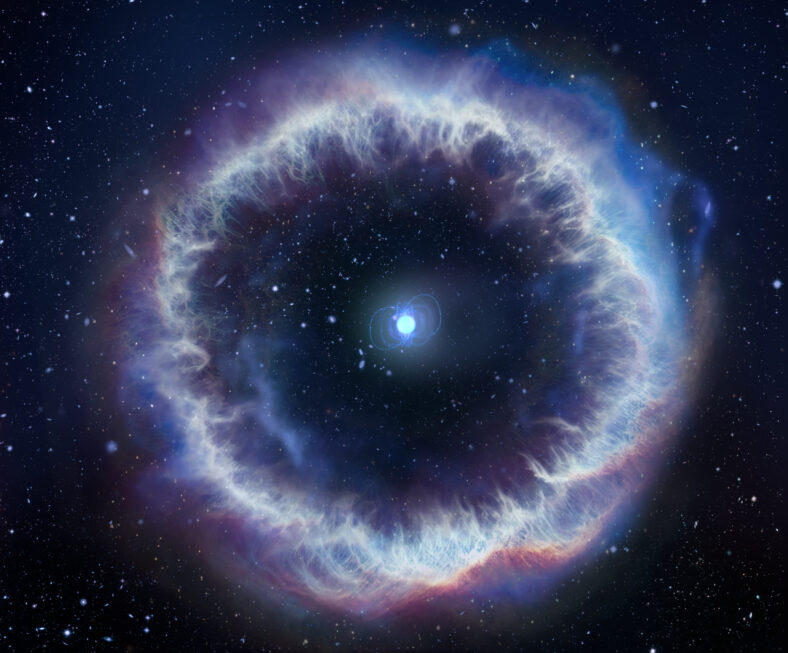The U.S. National Science Foundation National Radio Astronomy Observatory (NSF NRAO), in partnership with several leading Mexican universities and research institutes, has announced a series of landmark agreements and meetings aimed at advancing Mexico’s role in the Next Generation Very Large Array (ngVLA) project.
Recent News
Astronomers Discover a Superheated Star Factory in the Early Universe
Astronomers have uncovered a previously unknown, extreme kind of star factory by taking the temperature of a distant galaxy using the ALMA telescope. The galaxy is glowing intensely in superheated cosmic dust while forming stars 180 times faster than our own Milky Way.
Astronomers Share Largest Molecular Survey To-date: GOTHAM Legacy Data Goes Public
Astronomers in the “GBT Observations of TMC-1: Hunting Aromatic Molecules” research survey, known as GOTHAM, have released a spectral line survey with largest amount of telescope time ever conducted, charting more than 100 molecular species only found in deep space.
Plasma Bubbles and the “Engine” of Fast Radio Bursts

Unveiled Origins of Persistent Emissions in Fast Radio Bursts
The U.S. National Science Foundation (NSF) National Radio Astronomy Observatory (NSF NRAO) and the Karl G. Jansky Very Large Array (NSF VLA) have played a pivotal role in uncovering the origins of persistent emissions observed in some fast radio bursts (FRBs). An international team of astronomers has demonstrated that this persistent radiation originates from a plasma bubble, shedding new light on the enigmatic sources powering these cosmic phenomena. The groundbreaking results are published today in the journal Nature.
Fast radio bursts, first discovered just over a decade ago, are one of the most powerful and mysterious events in the universe, releasing vast amounts of energy within milliseconds. Despite extensive research, the precise mechanisms driving these bursts remain unclear. However, in a few instances, the brief flash of an FRB is accompanied by a weaker, persistent radio emission.
A new study, led by researchers from the Italian National Institute for Astrophysics (INAF) and involving collaborators from institutions worldwide, focused on FRB20201124A. You can read their full press release. This particular burst, located approximately 1.3 billion light-years from Earth, provided the team with unprecedented data, thanks to the NSF VLA, currently the most sensitive radio telescope in the world. Observations from the NSF VLA enabled the team to verify that a plasma bubble was responsible for the persistent emission observed in conjunction with FRBs. This supports the theoretical model predicting such an origin. The data suggest that the engine driving these FRBs could be a magnetar (a highly magnetized neutron star) or a high-accretion x-ray binary system, where intense winds from the magnetar or the binary system’s accretion process create this plasma bubble. The persistent emission associated with FRB20201124A is the weakest ever detected for an FRB, expanding the known range of these emissions by two orders of magnitude.
Gabriele Bruni, INAF researcher and lead author of the paper, explains, “Our observations confirm that the persistent radio emissions from FRBs behave as expected from the nebular emission model, indicating a bubble of ionized gas surrounding the central engine. This allows us to better understand the physical relationship between the engine of FRBs and the surrounding nebula.”
Luigi Piro, INAF researcher and co-author of the study, adds, “This research campaign, conducted at higher spatial resolution with the VLA, combined with observations in different bands from the NOEMA interferometer and the Gran Telescopio Canarias, has allowed us to reconstruct a comprehensive picture of the host galaxy and confirm the presence of a compact radio source— the FRB plasma bubble—within a star-forming region.”
The NSF VLA’s advanced capabilities were crucial in distinguishing the weak, compact emission from the surrounding diffuse emission, providing insights that previous studies could not achieve.
About NRAO
The National Radio Astronomy Observatory (NRAO) is a facility of the U.S. National Science Foundation, operated under cooperative agreement by Associated Universities, Inc.
This news article was originally published on the NRAO website on August 7, 2024.
Recent News
NSF National Radio Astronomy Observatory and Mexican Institutions Sign Historic Agreements to Advance ngVLA Collaboration
The U.S. National Science Foundation National Radio Astronomy Observatory (NSF NRAO), in partnership with several leading Mexican universities and research institutes, has announced a series of landmark agreements and meetings aimed at advancing Mexico’s role in the Next Generation Very Large Array (ngVLA) project.
Astronomers Discover a Superheated Star Factory in the Early Universe
Astronomers have uncovered a previously unknown, extreme kind of star factory by taking the temperature of a distant galaxy using the ALMA telescope. The galaxy is glowing intensely in superheated cosmic dust while forming stars 180 times faster than our own Milky Way.
Astronomers Share Largest Molecular Survey To-date: GOTHAM Legacy Data Goes Public
Astronomers in the “GBT Observations of TMC-1: Hunting Aromatic Molecules” research survey, known as GOTHAM, have released a spectral line survey with largest amount of telescope time ever conducted, charting more than 100 molecular species only found in deep space.
